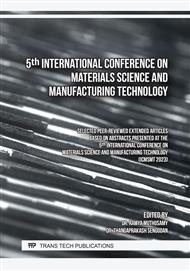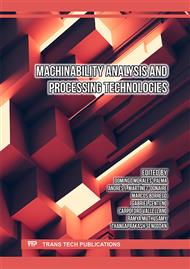[1]
King-Chi Lo, Heung-Wing Terry Kwok, Ming-Fung Francis Siu, Qiping Geoffrey Shen and Chi-Keung Lau (2021) "Internet of Things-Based Concrete Curing Invention for Construction Quality Control", Advances in Civil Engineering, Hindawi Publications, Volume 2021, Article ID 9933615 |.
DOI: 10.1155/2021/9933615
Google Scholar
[2]
Shemin T. John, Bijoy Krishna Roy, Pradip Sarkar and Robin Davis (2020), "IoT Enabled Real-Time Monitoring System for Early-Age Compressive Strength of concrete", Journal of Construction Engineering and Management, Volume 146, Issue 2, February 2020.
DOI: 10.1061/(ASCE)CO.1943-7862.0001754
Google Scholar
[3]
Volkan Arslan, Serdar Ulubeyli and Aynur Kazaz (2019), "The use of Internet of Things in the construction industry" UEMK 2019 Proceedings Book 24/25 October 2019 Gaziantep University, Turkey. (https://www.researchgate.net/publication/336890965)
Google Scholar
[4]
Harish Gopi Reddy and Venkatesh Kone (2019), "Study on Implementing Smart Construction with Various Applications Using Internet of Things Techniques", International Journal of Recent Technology and Engineering (IJRTE) ISSN: 2277-3878, Volume-7, Issue-6C2, April 2019.
Google Scholar
[5]
Syamsul H. Mahmud, Laromi Assan and Rashidul Islam (2018), "Potentials of Internet of Things (IoT) in Malaysian Construction Industry" Annals of Emerging Technologies in Computing (AETiC), Print ISSN: 2516-0281, Online ISSN: 2516-029X, pp.44-52, Vol. 2, No. 1, 1st October 2018, Published by International Association of Educators and Researchers (IAER).
DOI: 10.33166/aetic.2018.04.004
Google Scholar
[6]
Roy Woodhead, Paul Stephenson and Denise Morrey (2018), "Digital construction: From point solutions to IoT ecosystem", Automation in Construction 93 (2018) 35–46.
DOI: 10.1016/j.autcon.2018.05.004
Google Scholar
[7]
Jochen Teizer, Mario Wolf, Olga Golovina, Manuel Perschewski Markus Propach Matthias Neges and Markus König (2017), "Internet of Things (IoT) for Integrating Environmental and Localization Data in Building Information Modeling (BIM)", 34th International Symposium on Automation and Robotics in Construction (ISARC 2017). (https://www.iaarc.org/publications/fulltext/ISARC2017-Paper084.pdf).
DOI: 10.22260/isarc2017/0084
Google Scholar
[8]
Han-Seung Lee, Myoung-Won Cho, Hyun-Min Yang, Sung-Bok Lee and Won-Jun Park (2014), "Curing Management of Early-age Concrete at Construction Site using Integrated Wireless Sensors", Journal of Advanced Concrete Technology Vol. 12, 91-100, March 2014. (.
DOI: 10.3151/jact.12.91_100
Google Scholar
[9]
Akula Prakash , Kandlagunta Mounika , Anand Goud K and Vittalaiah A (2021), "Construction Automation", IOP Conf. Series: Materials Science and Engineering, 1091 (2021) 012036. (.
DOI: 10.1088/1757-899x/1091/1/012036
Google Scholar
[10]
Zhong, R.Y., Peng, Y., Xue, F., Fang, J., Zou, W., Luo, H., Ng, S.T., Lu, W., Shen, G.Q., Huang, G.Q." Prefabricated construction enabled by the Internet-of-Things". Automation in Construction 76, 59–70 (2017).
DOI: 10.1016/j.autcon.2017.01.006
Google Scholar
[11]
Norris, A., Saafi, M., Romine, P. "Temperature and moisture monitoring in concrete structures using embedded nanotechnology/microelectromechanical systems (MEMS) sensors. Construction and Building Materials" 22(2), 111–120 (2008).
DOI: 10.1016/j.conbuildmat.2006.05.047
Google Scholar
[12]
Akula Prakash, A.N. Swaminathan, Akoju Ramu, Bypaneni Krishna Chaitanya (2021), "Assessment of strength and durability parameters for concrete with partial replacement of coarse aggregates by iron slag and glass powder as an additive", IOP Conf. Series: Materials Science and Engineering, 1126 (2021) 012082. (
DOI: 10.1088/1757-899x/1126/1/012082
Google Scholar



